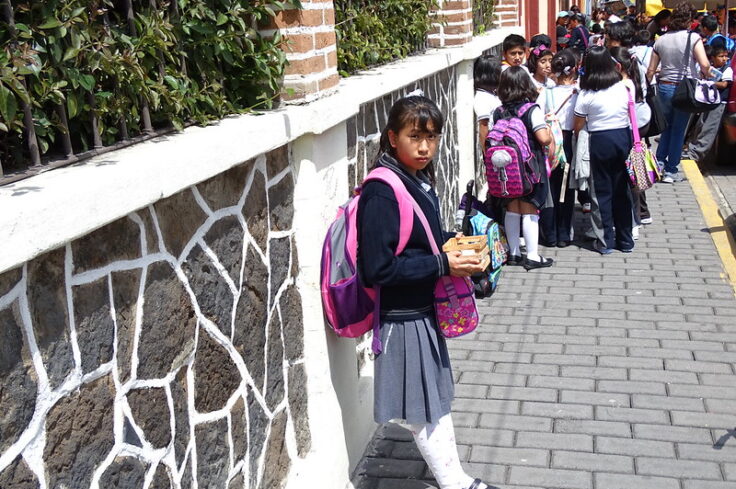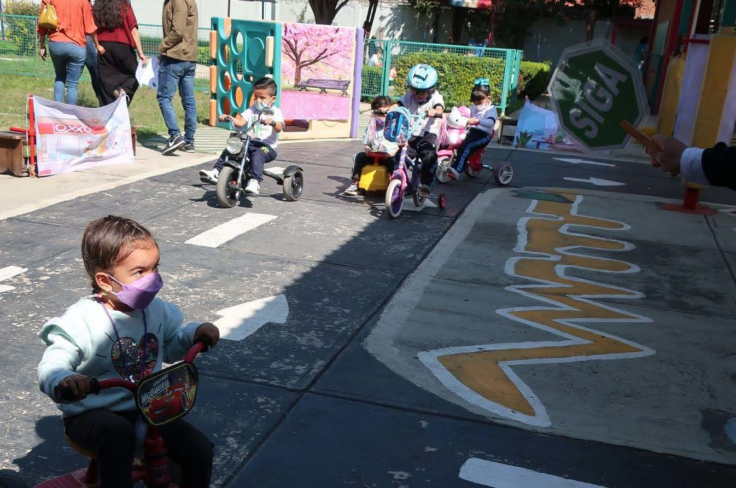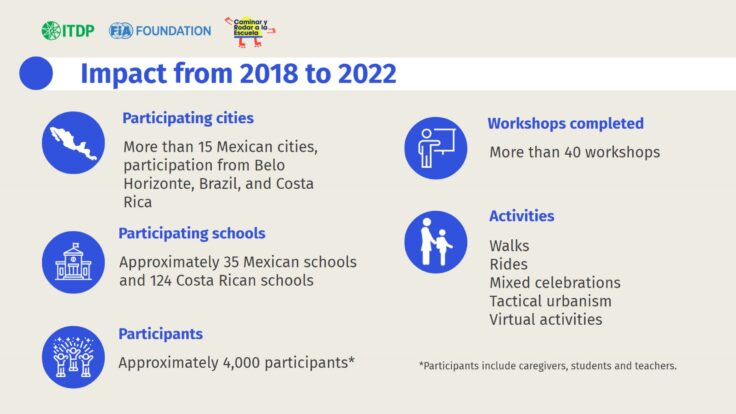October 11, 2023
Advocating for Safer Routes to School for Children Across Mexico
A growing epidemic of traffic injuries is devastating the next generation of children around the globe. According to Safe Kids Worldwide, traffic collisions are the number one cause of death among children ages 5 to 19 worldwide.
In the Global South, children are particularly at high risk of traffic violence, with more than 90% of reported child road deaths occurring in low- and middle-income countries. As the number of vehicles on the roads is on pace to double by 2030, the car-first culture in our cities — and the related traffic violence — is set to cost the global economy billions each year while further exacerbating the climate crisis with rising emissions. Addressing these urgent concerns requires comprehensive mobility policies and interventions that start by protecting our most vulnerable populations of children. The safety of children and students living in cities requires more immediate attention and action, considering that many countries still do not have targeted regulations protecting the rights of pedestrians and cyclists in school zones. The right to a safe route to school helps ensure that students can access education and experience their cities in a healthier and more productive environment.
In Mexico, ITDP has been working on national and regional road safety strategies to support children and school communities by developing policy frameworks highlighting vulnerable communities’ unique needs and perspectives. For this year’s annual Walk and Roll to School Day, ITDP Mexico and partners at the FIA Foundation released a Walk and Roll to School Guide for Mexican Cities that aims to encourage more city governments and decision-makers to establish safer routes to school everywhere. The Walk and Roll to School Day celebration is an annual event that, since 1997, has engaged communities worldwide in walking and cycling to school together on the same day to continue advocating for more road safety and complete streets. Now celebrated in over 40 countries, the Day ultimately aims to unite people in promoting sustainable, accessible, and inclusive mobility, particularly in communities where walking and cycling are the only options for students.

“The Guide will be an instrument that will allow authorities from [Mexico’s] three levels of government to understand the road ahead and how to make changes safely and enjoyably.”
– Roxana Montealegre, Director of Mobility of the Ministry of Agrarian, Territorial and Urban Development (SEDATU) of Mexico
The Guide offers critical insights, lessons, and technical details on various Walk and Roll to School events that partners have organized nationally since 2018, including activities that ITDP has promoted in the nearby country of Costa Rica since 2021. The Guide is also part of a broader Vision Zero for Youth Initiative for Mexico that prioritizes improvements in road safety using a ‘Safe System’ approach to policy and implementation. This approach is primarily human-centered, prioritizing safety in built environments without accepting trade-offs between human lives and other priorities, such as vehicle traffic. First widely applied to road safety in the 1990s, the approach requires a universal shift in business-as-usual transport and urban development in order to provide all modes of mobility with consideration and protection.
Beyond the Walk and Roll to School Day celebrations, the Vision Zero program in Mexico is also focused on promoting pilots for various road safety interventions around schools, providing technical guidance for municipalities, and conducting public policy evaluations on speed limits and related measures. By directly connecting local communities with public authorities, Walk and Roll to Schools Day is an important advocacy and awareness tool for everyone working to advocate for safer road conditions as part of broader mobility, accessibility, and climate change policies.
More complete street designs and policies prioritizing pedestrian, cycling, and public transit circulation not only encourage fewer emissions-heavy car trips, but also allow families and children more protected and active options for commuting. To protect all people on the road, it is crucial to ensure that speed limits are well-regulated and enforced and that roads are not designed in a way to facilitates speeding or the mixing of traffic. The Walk and Roll to School initiative offers an essential platform for planners and policymakers to learn about the unique mobility needs of children, students, and their caregivers and to witness first-hand the impacts of road safety measures on local neighborhoods. The Day also empowers more communities, children, and caregivers to directly advocate for their concerns to public authorities and demand tangible changes to their environment.


More than 15 Mexican cities and other municipalities in Costa Rica have participated in six editions of Walk and Roll to School, creating an important open space for civic dialogue, reflection, and advocacy. During the release event for the Guide, ITDP Mexico highlighted the need for more collaboration between civil society and governments, spotlighting the many mobility challenges currently faced by children and students — particularly those from low-income areas — in public spaces. In addition, representatives from the FIA Foundation discussed the initiative’s growth along with the need to scale Vision Zero programming in Mexico’s cities. Walk and Roll to School Day is just one component of a larger movement to engage school communities and civil society groups with more governments and policymakers to help them imagine a world where children and families can travel safely and sustainably. Safer roads to school are, ultimately, safer roads for all of us.
Download ITDP Mexico’s Guide here and view the webinar below for more on our work on road safety and schools.
